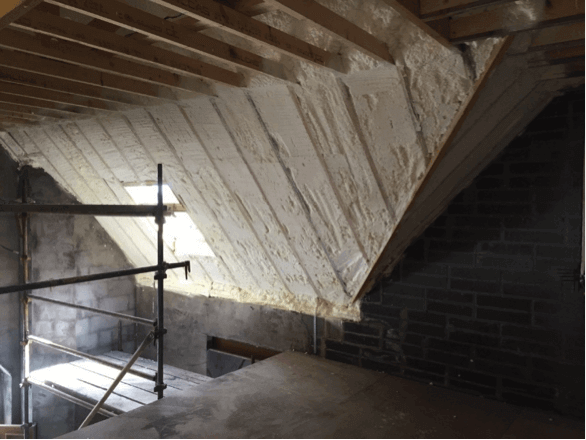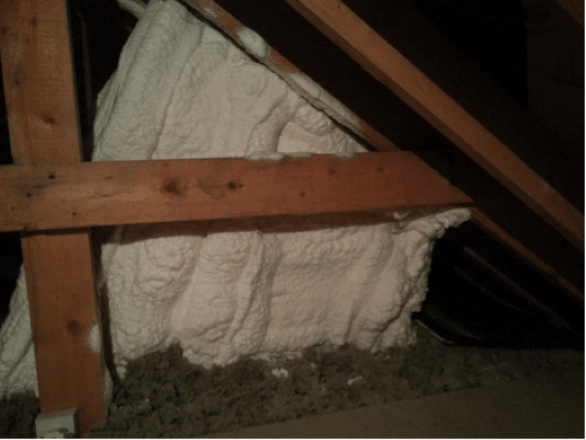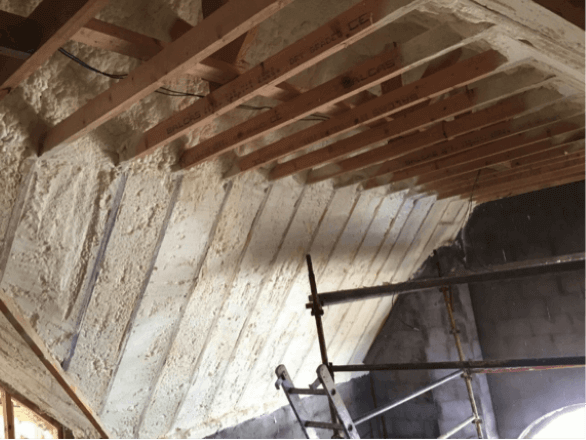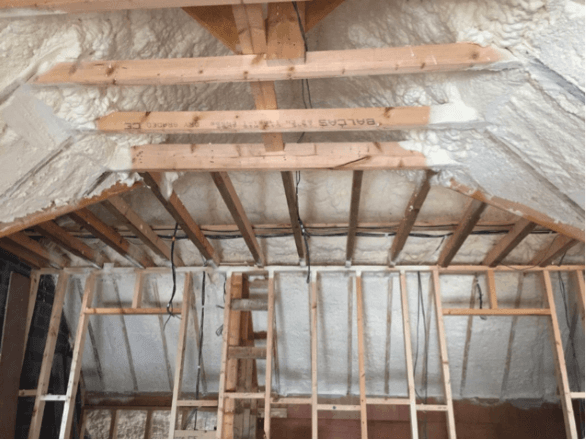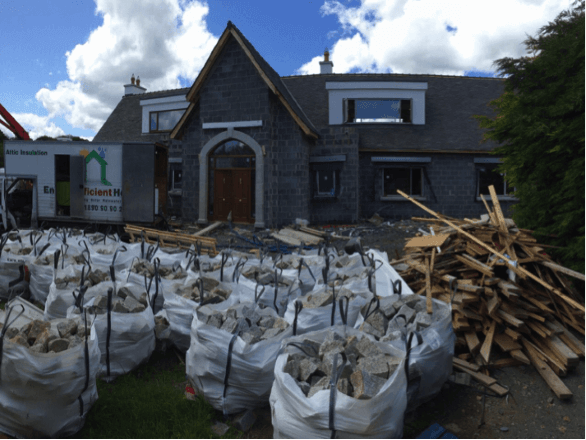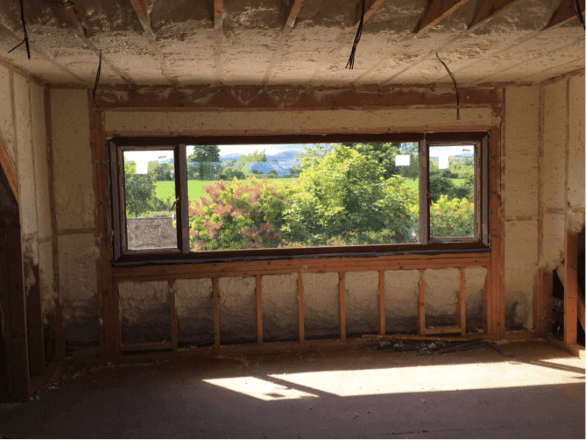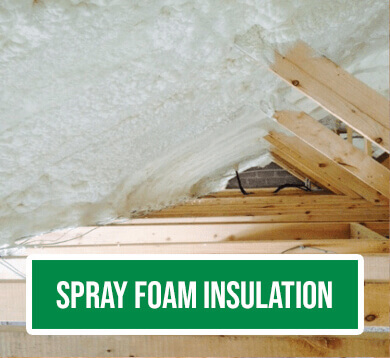Spray Foam performs better as it keeps cold air out and traps heat better making it harder for heat to escape. When you Spray Foam your home you notice the difference straight away.
Spray foam insulation is the best form of insulation system. Every home should have it installed.
Pat Mac Connell, Air Pump and Tool LTD, Dunshaughlin. View their website here.
Cards installed for ventilation
About our spray foam insulation business, Energy Efficient Homes Ltd.
Spray foam insulation comes in two basic forms, “open cell” or (1/2 lb) and “closed cell” or (2 lb) there are some additional hybrid variations for specialist applications also.
As the names suggest the main difference in the open or closed cell spray foam insulation is the structure of the cells within the cured foam.
An open cell foam is of a density which is approximately 70% open, making it “permeable” or to quote the more commonly used phrase “breathable” and is best suited for timber structures such as roofing or stud work. This means the foam will absorb moisture and release it in the same way natural products such as timber will, which is necessary to maintain durability and structure. http://loans-cash.net.
Open cell foam is light, semi-rigid and classified as a vapor retardant. When spray foam insulation is applied it will expand at a ratio of 1 – 100, thus creating a perfect airtight fit on any surface or in any hard to access space.
Closed cell spray foam insulation is a more solid and rigid product, classified as a complete vapor barrier which means it is totally water resistant. It has an expansion ratio of 1 – 20 which allows it to maintain all contours and seal all joints on the surface to which it is applied.
It is best suited to metal structures such as commercial or agricultural buildings or in some cases it may be used as a base coat before finishing with open cell spray foam insulation, to add rigidity and bonding to older roofing structures.
A liquid polyurethane is sprayed onto the surface you want to insulate and it expands within three to five seconds to form an airtight thermal and vapor barrier. When applied the spray foam insulation will expand by a ratio of 1 / 100 to create a perfect airtight fit and eliminate all heat loss.
Where can spray foam insulation be used?
Spray foam insulation systems offer numerous solutions for roofing, sound absorption and heating cost reduction depending on individual needs and budget.
At I.S.F. Energy Control, we supply and install a series of spray foam insulation systems designed for residential, commercial and industrial applications. In addition to attics, it is well suited to metal structures (commercial / agricultural buildings).
What are the benefits of spray foam insulation?
Overall the benefits are lower running costs for both heating and cooling. The results are immediate and will remain in place for the life of the structure.
With spray foam insulation, there is also a wide range of further benefits.
It eliminates air gaps in the building envelope which are unavoidable with conventional insulation. This means eliminating condensation, drafts, noise and other external effects. Spray foam insulation will reduce the amount of pollutants and allergens that enter a building structure. Rain water is eliminated from entering the attic, reducing the risk of fungal growth and damage to the building's structure.
Closed-cell spray foam insulation offers the best U-value per inch of any insulation system available.
Spray foam insulation will add support and rigidity to aging roofing structures such as “Bangor blue” slates to prevent sagging or slates slipping.
Is spray foam insulation environmentally friendly?
I.S.F. Energy Control spray foam insulation systems are eco-friendly using renewable energy sources, such as caster, sugar cane. Using our products in your home or business will help reduce the emissions of greenhouse gasses (carbon footprint) into the environment such as carbon dioxide and methane. I.S.F. Energy Control spray foam insulation also contains no H.C.F.C.’s, V,O.C.’s, or formaldehyde, they will not settle, sag or decay and there is no off-gassing over time.
Does spray foam insulation “settle” over time?
Spray foam insulation will not sag, settle, or lose its U-Value over time unlike tradition glass fiber or loose fill insulation products.
Will spray foam insulation cause the building to “weaken” in any way?
No. In fact, spray foam insulation adds significant structural strength to any home or building to which it is applied. In many tests conducted, closed cell spray foam insulation has doubled the racking load making your home more resistant to severe weather conditions.
Is spray foam insulation breathable/permeable? And why is that important?
Non-breathable/permeable insulation can cause a build-up of condensation. Open cell spray foam insulation is 90 to 96% breathable and is the most popular spray foam insulation at the moment for residential properties due to its cost-effectiveness and energy saving factors. Where a vapor barrier is required, closed cell spray foam insulation is specifically designed as damp proofing and a vapor barrier with excellent U values in a perfect airtight fit.

We gave this home owner some great spray foam insulation solutions and information that he loved and then we both agreed on a realistic figure and works commenced.

Here you can see the ventilation spacer cards installed between the rafters, ready for the spray foam insulation.
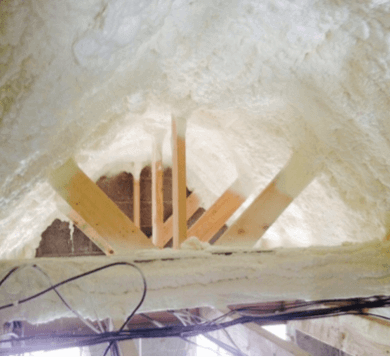
We left a large ventilation gap for a healthier timber and then sprayed in front of the timber to stop them pulling out the heat. Moisture will move through the system and into the ventilation gap keeping everything healthy and happy.

This spray foam insulation was really consistent and the application was great.
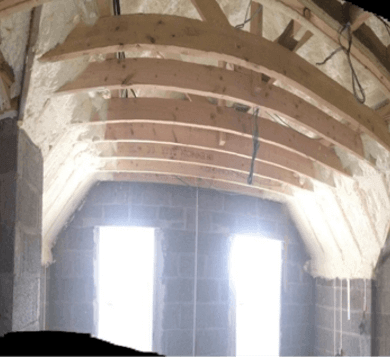
A well-insulated attic with perfect seals around the edges will ensure that our client saves great money on his heating and is nice and comfortable without the heating on.
We’ve mentioned “U-Values” – what exactly are they?
A “U-Value” is a theoretical calculation of a structure’s thermal resistance, or its ability to retain heat. In other words, a “U-Value” will give an approximate measurement of how difficult the material will make it for heat to pass through it. This also applies in summer conditions when cooling is desired.
Open-cell sprayed foam insulation offers the best “U-value” of any breathable insulation material on the market.
Is the U-Value of an insulation all you need to know?
No. These U-Value calculations are achieved in laboratory conditions and have only a vague connection to real-world situations, where poor installing methods and inaccurate measurements are commonplace and often shifting or sagging of materials occurs. These elements severely impact on the overall performance of the insulation system. In addition to these problems, many materials have a propensity to retain moisture, given that they are neither breathable nor permeable such as rigid high-density boards or glass fibre quilts.
In effect, the “U-Value” is only half the story.
Commonly, an insulation material can have a fantastic “U-Value” on paper but doesn’t seem to be doing its job in practice, it is only then you realize that “U- Values” are only half of the picture and that without air tightness they just don’t work. In the home, office or commercial building, the only way to really impact on costs and comfort is make it airtight.
Air Tightness – the other piece of the puzzle!
The ideal system is one that not only has a low “U-Value” but is also forms an air tight seal while allowing the structure to breathe. Sprayed foam insulation is the only system available on the market today which performs all of these tasks in one simple step.
Don’t we need air flow for ventilation?
Yes, but in a controlled fashion. Air leakage is the uncontrolled flow of air through gaps and cracks in the structure or fabric of a building (sometimes referred to as infiltration or draughts) which result in discomfort for occupiers and rising costs. This is not to be confused with ventilation, which should be a controlled flow of air into and out of the building through purposed built ventilators for the comfort of the occupants.
Too much air leakage leads to unnecessary costs, heat loss and discomfort to the occupants from cold and draughts. The increasing need for higher energy efficiency in buildings and the need in future to demonstrate compliance with more stringent “Building Regulation” targets mean that air tightness has become a major performance issue. The aim should be to ‘Build tight- make it airtight’.
Heat loss/air leakage directly impacts on the performance of any building. From running costs to general comfort the benefits of an airtight structure are obvious,. Air tightness of existing buildings has been proven to be poor, which leads to unnecessary heat loss, greatly increased costs but also widespread occupant dissatisfaction.
How does spray foam make it airtight?
With spray foam, there is no cutting, no measuring, and no waste, it is simply sprayed in place and expands at a ratio of 1/100 creating a perfect airtight fit. Even in those difficult places where it is physically impossible to gain full access.



